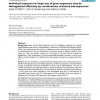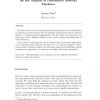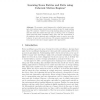10602 search results - page 65 / 2121 » Weakly Useful Sequences |
BMCBI
2005
13 years 9 months ago
2005
Background: Most current DNA diagnostic tests for identifying organisms use specific oligonucleotide probes that are complementary in sequence to, and hence only hybridise with th...
NAR
2006
13 years 9 months ago
2006
Expresso is a multiple sequence alignment server that aligns sequences using structural information. The user only needs to provide sequences. The server runs BLAST to identify cl...
TCS
2008
13 years 9 months ago
2008
Analysis of Distributed Abstract Machines Damien Pous ENS Lyon, France. We illustrate the use of recently developed proof techniques for weak bisimulation sing a generic framework...
ISVC
2010
Springer
13 years 7 months ago
2010
Springer
We present a novel framework to reliably learn scene entry and exit locations using coherent motion regions formed by weak tracking data. We construct “entities” from weak trac...
BMCBI
2004
13 years 9 months ago
2004
Background: For the purposes of finding and aligning noncoding RNA gene- and cis-regulatory elements in multiple-genome datasets, it is useful to be able to derive multi-sequence ...



